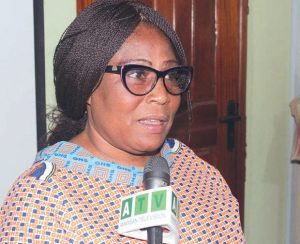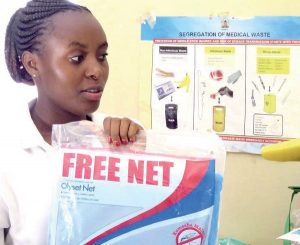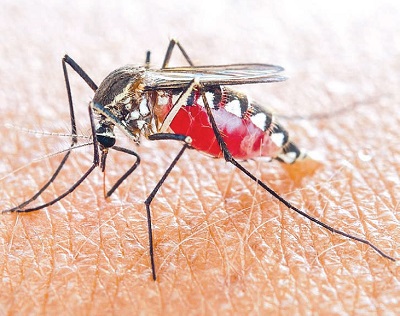“Every night my family sleeps under the mosquito net and we are safe from malaria,” Jemima Asante reveals.
“We have not been to the hospital for malaria in the past two years since we started sleeping under the mosquito net I was given when I was pregnant,” she adds.
Thirty-two-year-old Jemima is a senior high school graduate who manages her hairdressing business in the Ogbodjo community in the Adentan Municipality of the Greater Accra Region.
She says being introduced to the practice of sleeping inside an insecticide treated mosquito net every night and throughout the night has greatly helped her in taking care of her family.
“I can have time for my business and family as I do not have to be in the hospital with my sick child or husband for malaria,” she indicates.
The anopheles mosquitoes carry the plasmodium parasite which causes malaria and bites at night, with their peak biting times being between dawn and dusk.
Therefore, sleeping inside a treated mosquito net at night is a sure way to break the transmission of the plasmodium parasite from mosquitoes to humans.
This implies that the distribution and use of long lasting insecticide treated nets (LLINs) is one of the central interventions for preventing malaria infection in Ghana.
Frees LLIN Campaign
The Ghana Health Service (GHS), through the Ghana National Malaria Control Programme in 2012, began the implementation of a strategic plan to achieve universal coverage for LLINs for the Ghanaian population through time-limited, national, free distribution campaigns of LLINs.
In the first campaign that ended in 2012, more than 12.4 million LLINs were distributed in all 10 regions of Ghana.
Between 2014 and 2016, a second LLIN mass distribution campaign was implemented in all 10 regions of Ghana.
In the Eastern and Volta Regions, the LLIN distribution was conducted in 2014, while Ashanti, Brong Ahafo, Central and Western Regions were covered in 2015.
In the remaining four regions (Greater Accra, Northern, Upper East and Upper West), the LLIN distribution campaign was conducted in 2016.
“While mass campaigns rapidly increase the ownership of LLINs, the coverage gaps appear almost immediately post-campaign through net deterioration, loss of nets, and population growth. Thus, complementary continuous distribution channels are required,” the Malaria Indicator Survey (2016) conducted by the Ghana Statistical Service states.
Data from the National Malaria Control Programme (NMCP) shows that for the Greater Accra and Western Regions, the 2014-2106 campaign reached only approximately 80 per cent of the households.
In contrast, the 2014-2016 LLIN distribution campaign reached 95 per cent of the households or more in all the other regions.
However, the Greater Accra Region recorded the lowest prevalence for malaria for five per cent.
“In the Greater Accra Region, our parasite level is much lower than any other in the country. Because we have a lot of health facilities once you are reporting promptly it will be under control because they will receive treatment which kills the parasite so and therefore the mosquito will not transfer the parasite from one person to the other,” Dorothy Abudey, Greater Accra regional malaria focal person, says
Explaining further, she opines that malaria cases recorded at the out-patient departments (OPDs) have decreased from 449, 327 in 2014 to 342,896 in 2017, under five mortality due to malaria has also reduced from 31 to 6 within the same period in the region.
“Above five years of age malaria mortality has also reduced from 72 to 14 between 2014 and 2017,” she adds.
Using LLIN
Jemima says using the LLIN was not easy at the beginning as she struggled to cope with the warmth that came with it.
“When you see my house, you can see that the ventilation is poor so it gets hot in the dry season so using another thing to further block the air flow from coming to you when you sleep was a real challenge,” she says.
“I was turning in bed the whole of the night because I was pregnant at the time and you can just imagine the discomfort but because the nurses told me it was for my health and that of the baby I manage and I have not regretted,” Jemima adds.
Mrs. Abudey explains that because the manufacturing components of the nets, the public is always advised to hung it under a shade once they receive it for sometime before they sleep under it at night.
She says misconceptions surrounding the usage of the free nets and the use of the nets for other purposes are affecting the coverage targets of the LLINs.
“We encourage people to use the net at night and not for other purposes,” she stresses.

Dorothy Abudey
Greater Accra Point Mass Distribution
The Greater Accra Regional Director of Health Services, Dr. Charity Sarpong, says the ‘point mass distribution’ campaign for the region this year is to consolidate gains of the region in its malaria control programme.
She indicates that the house-to-house campaign will begin with a registration process from November 6 to November 12, 2018 before the distribution exercise from November 22 to November 28, 2018.
“This is important so that we know how many nets should be given to each household,” she explains.
The region is this time around deploying the use of an electronic app installed on a handled device and would request details, including name of household, number of people in the household, house number and contact number.
“The electronic app will generate a unique code for each registered household which will indicate the number of LLINs to be allocated for each household.
The unique codes will be written on cards and the household heads or representatives will have to present their cards from only their households at distribution points for issuance of the free bed nets,” Dr. Sarpong adds.
Mrs. Abudey says the region has targeted a total of 2,773,696 LLINs to be distributed within the seven-day period to a targeted population of close to 5:00pm.
“This time around we are looking at having 90 per cent coverage registration and 90 per cent distribution coverage,” Mrs Abudey indicates.
“Because we believe that sleeping inside long lasting insecticide treated nets every night and all throughout the night is the best way to protect individuals and families from malaria.”
“Listen when you calculate the cost of time you will waste at the hospital and money due to malaria, every Ghanaian would want to sleep under a treated mosquito net at night,” Jemima says.

Pull Out
Private Sector Support
The World Malaria Report 2017 shows that after unprecedented global success in malaria control, progress has stalled.
There were an estimated 5 million more malaria cases in 2016 than in 2015. Malaria deaths stood at around 445 000, a similar number to the previous year.
In recent years, major gains have been made in the fight against malaria, and with a little more push financially missing the global malaria targets for 2020 and beyond can be met.
The WHO Global Technical Strategy for Malaria calls for reductions of at least 40 per cent in malaria case incidence and mortality rates by the year 2020.
According to WHO’s latest malaria report, the world is not on track to reach these critical milestones.
A major problem is insufficient funding at both domestic and international levels, resulting in major gaps in coverage of insecticide-treated nets, medicines and other life-saving tools.
Thus, it this is a wake-up call for the global health community.
Meeting the global malaria targets will only be possible through greater investment and expanded coverage of core tools that prevent, diagnose and treat malaria.
Robust financing for the research and development of new tools is equally critical.
By Jamila Akweley Okertchiri


